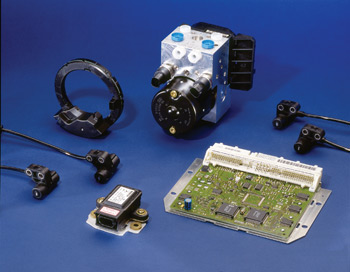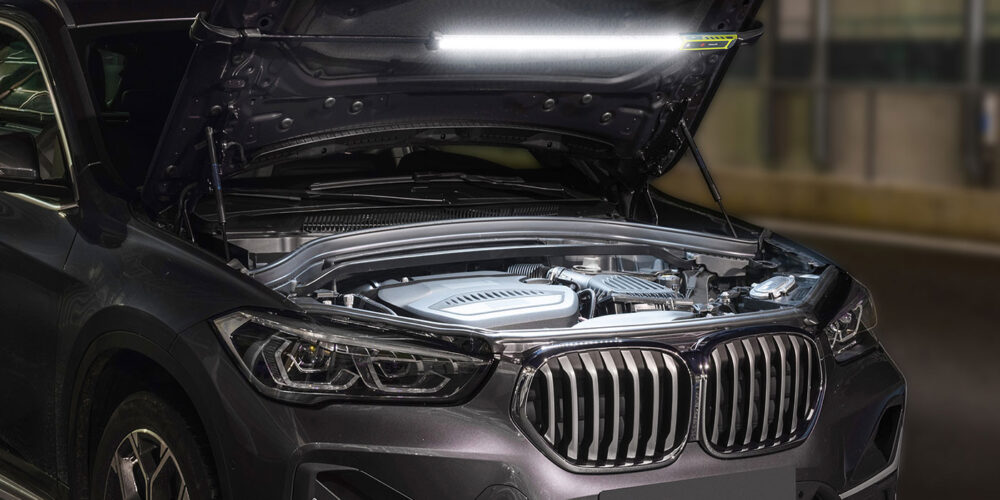If Brake Assist is not working, at worst the vehicle should have normal power braking (assuming the hydraulic brakes and vacuum booster are functioning normally). The driver may not even realize something is wrong unless there’s a warning light on the dash. That’s because Brake Assist comes into play only in emergency-stop situations.
Common problems that can prevent a Brake Assist system from working properly include anything that prevents the ABS system from developing normal pressure in the accumulator. That includes a bad ABS pump relay, failed pump motor or a leak in the high-pressure accumulator. A failure of the brake control module or brake pressure load switch would also prevent Brake Assist from intervening in an emergency.
BRAKE ASSIST PLUS
In 2006, Mercedes upped the capabilities of its Brake Assist system by adding a collision-warning feature using radar to detect other vehicles or obstacles in the road ahead. By monitoring the closing distance between the vehicle and other cars or objects in the road ahead, the system can warn the driver if braking is needed. The brake system is also pre-charged to decrease the reaction time when the brakes are applied. Mercedes calls this Brake Assist Plus, and uses it on its S-Class cars.
The radar-ranging feature comes from the car’s adaptive cruise control system that maintains a safe distance between vehicles rather than a preset speed while driving. The “Distronic” cruise control system uses a radar transponder and receiver mounted behind the grill to scan the road ahead. The data is then shared with the Brake Assist Plus system to keep the driver informed of any possible hazards, and to pre-charge the brakes if it appears that braking will be needed.
MERCEDES PRE-SAFE BRAKING
Taking this technology a step further, Mercedes added a new feature in its 2007 and up S-Class and CLS-Class models. It’s also found on its 2009 E-Class models. It’s called “Pre-Safe” braking. With this system, the brakes are lightly preloaded if the system senses braking will be needed because the vehicle is approaching a stationary object in the road ahead, or the vehicle ahead is braking. The system will flash a warning to alert the driver. If the driver fails to react in time, Pre-Safe braking takes over and applies partial braking (about 40% of maximum brake force) to slow the vehicle.
The Pre-Safe system uses two near range radar sensors behind the front bumper to detect vehicles ahead, with a maximum range of 30 meters, at an angle of up to 80 degrees. An additional long-range radar sensor is located in the grille to detect vehicles up to 150 meters ahead (200 meters on 2009 models). The system is active from 30 to 112 mph on the 2007 and 2008 applications, and up to 124 mph on the 2009 and 2010 models, but intervenes only with automatic braking if the car is approaching a stationary vehicle from behind at speeds under 43 mph.
MERCEDES SENSOTRONIC BRAKES
Another variant of Brake Assist that Mercedes uses on some of its vehicles is its Sensotronic Brake Control (SBC) system. This electronic braking system has no vacuum booster. It uses pressure from the ABS pump and accumulator for normal braking as well as Braking Assist and ABS braking. It does have a conventional master cylinder for fail-safe backup. The master cylinder also has a pedal pressure sensor (actually two Hall Effect sensors in one unit), and a pedal simulator to simulate the feel of a conventional brake system. 
Sensotronic was introduced in Europe in 2001, and on U.S. SL-Class and E-Class cars in 2003. Sensotronic is still used on SL-Class models, but was discontinued on the E-Class models in 2006 due to recall problems (wiring harness problems and control module glitches). If a fault causes the system to shut down, the brakes revert to conventional manual brakes with no power assist.
The Sensotronic brake system combines Brake Assist, brake system precharging, antilock braking and stability control into one integrated system. It does not, however, provide any collision warnings or automatic braking as with Pre-Safe braking.
The system is activated as soon as the doors on the vehicle are unlocked, or when the driver turns on the ignition or steps on the brake pedal. It immediately performs a pre-drive self-check by checking all the system sensors, operating the ABS pump and applying pressure to the calipers. It repeats this self-check every 16 brake applications while the car is being driven.








